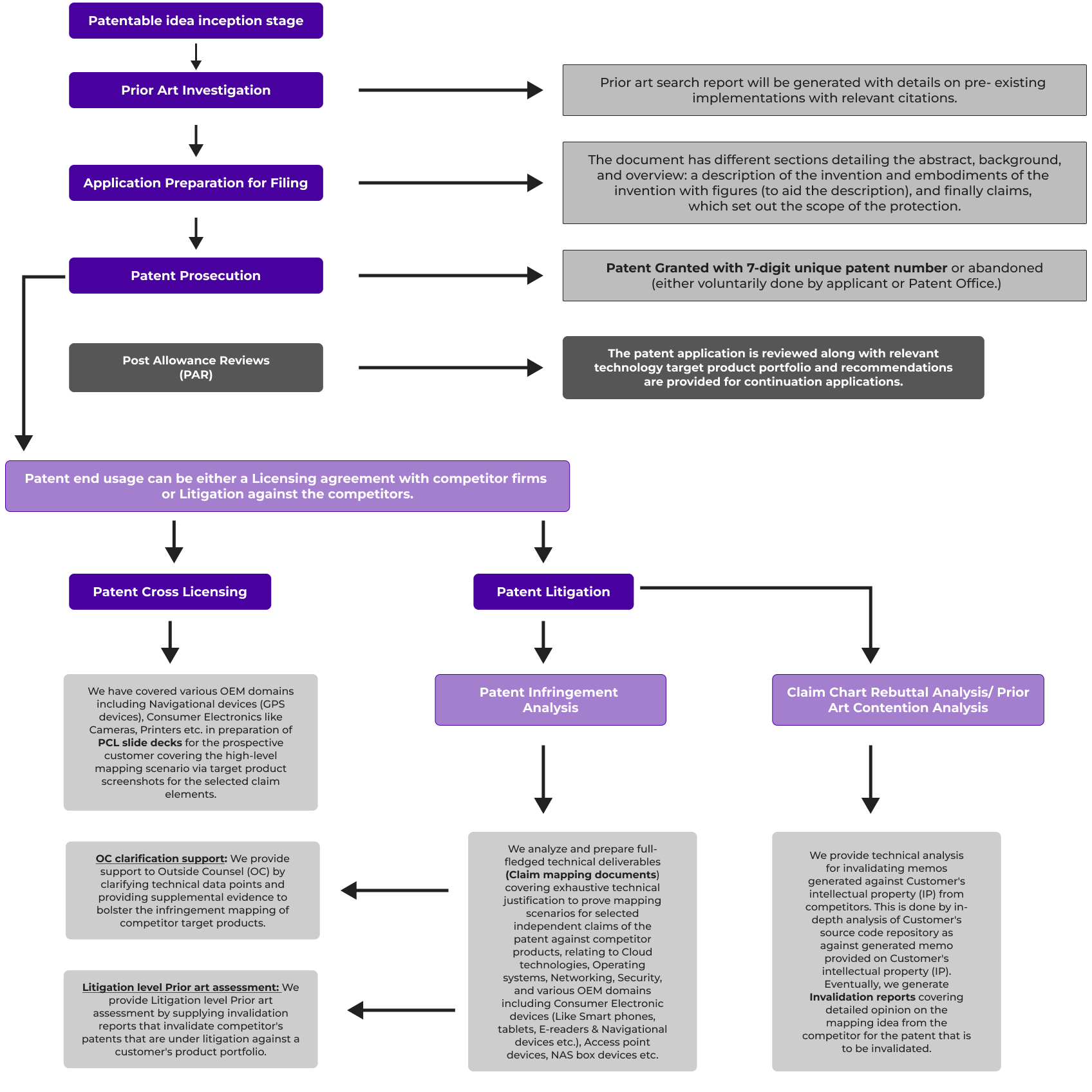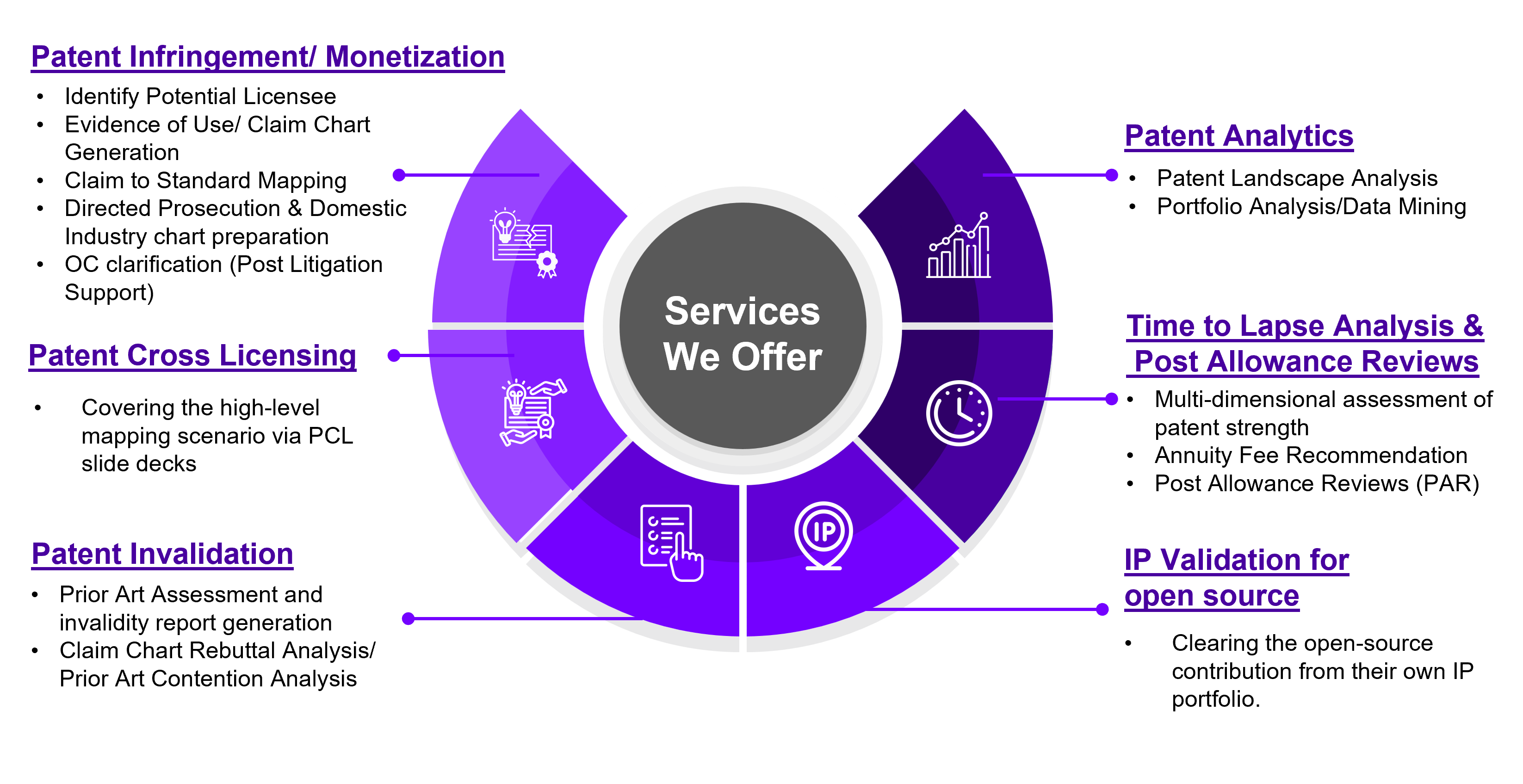IP services (Patent Analysis)
Intellectual Property (Patent) Services practice helps in preparing technical summary on patent infringement by justifying adequate proof of evidence in the form of screenshots, video grabs, internet literature, and relevant source code snippets (if available) on the target product infringing the patent. Also, we try to bolster the mapping with inside details of relevant target OEM (Original Equipment Manufacturer) devices by performing reverse engineering steps.
Our IP Services team is better equipped with technical skills along with IP domain expertise for patent infringement analysis. The combination of IP skills with technology knowledge would ensure good articulation for mapping invention steps with target products/tech areas to generate technically credible deliverables for the customer.
Our core IP Services are project-based engagements to ensure a high degree of confidentiality while performing infringement analysis and at the same time maintaining an acceptable level of risk and compliance within an organization.
The IP services team works closely with clients to understand their requirements thoroughly and develop efficient mapping deliverables, which will help customers in handling licensing and litigation exercises very confidently. We would also provide post-litigation support in the form of Outside Council Queries (OC queries) to enhance customer chances of winning the litigation deal.
Our goal is to help clients protect and monetize their IP (patents) portfolio with minimum investment, protect their assets, and respond effectively to any legal circumstances & queries.
The intellectual Property analysis spectrum is very broad. Each task involved in this landscape is highly time-critical and priority-driven. Hence, every technical input and documented recommendation would be critical to a customer’s credibility with their competitors.
The diagram below depicts a flow from the inception of a patentable idea to its usage in the form of Licensing or Litigation. The grey highlighted boxes are the services offered by Quadrant Technologies.
Patent Application Flowchart

Patent Analysis services offered
- Patent Infringement/ Monetization
- Patent Invalidation
- Patent Analytics
- Time to Lapse Analysis /Annuity Fee Recommendation Analysis and PAR Reviews
- Patent Cross Licensing
- IP Validation for Open Source

1. Patent Infringement/Monetization
Patent infringement/Monetization involves the following aspects:
a) Identify Potential Licensee:
We proactively analyze features of potential competitor products in specific technology areas and build high relevancy keywords to pull relevant patents from Customer portfolio and provide recommendations to the Customer about the potential patent infringements in competitor product landscape.
b) Evidence of Use/ Claim Chart Creation
Patent infringement Analysis is the process of preparing technical summary on patent infringement by justifying adequate evidence of use in the target products infringing the patents. In order to ascertain infringement or evidence of use, we primarily rely on the following sources:
- Source Code Repositories.
- Web sources/ Product Features
- Tutorials / Tech Blogs
- User Manuals/ Data sheets / Help Files
- YouTube Videos
- Actual Product Testing
If in case source code is available (for Open-Source products), we conduct detailed OEM source code analysis & debugging (after installing the setup if feasible) to capture live call stack trace for EoU (Evidence of Use) generation. Also, to strengthen the mapping and to ascertain the applicability, we perform reverse engineering to extract internal details of the OEM devices and/or running applications.
A few exemplary techniques are:
- Disassembling and de-compilation of Android apps (Customized or proprietary apps) after extracting them from the device.
- Android applications database analysis using SQLite Manager
- Usage of scripts to retrieve internal information of the OEM devices (e.g., formatted file systems, power management details, processor, and system on chip (SOC) details etc.)
- Network packet Sniffing (Wireshark/Ethereal and tPacketCapture (for android devices))
c) Directed Prosecution & Domestic Industry chart preparation.
Directed Prosecution – Here we do analyze pending patent applications by referring to “Patent Center” (former public pair) for latest amended claims, curating patent scope (claim scope) in a way that it becomes more commercially valuable by generating EoUs for pending patent applications.
Domestic Industry – Generating EoUs substantiating the fact that customers implement their own IP into its products. This is to check the practice of patents in their own products or solutions.
d) Claim to Standard Mapping
We also provide claim mapping of Customer’s portfolio of patents as against standard specifications, such as, HTML specification, USB 2.0, USB 3.0, USB 3.2 specifications, exFAT file system specification, Common Internet File System (CIFS) specification etc.
e) OC clarifications (and Post Litigation Support)
We provide 24x7 support to Outside Counsel (OC) by clarifying technical data points and providing supplemental evidence of infringement in competitor products, thereby bolstering infringement mapping documents prepared against competitor companies and paving way for favorable judgements for Customers in cases under litigation. We also provide Litigation level Prior art assessment by supplying invalidation reports that invalidate competitor’s claim charts and their patents that are under litigation against a Customer’s product portfolio.
2. Patent Invalidation
Patent invalidation activity involves following aspects:
a) Prior art assessment/investigation & Invalidity Memo Generation:
- Involves intense search for any available disclosure: literature, documentation and source code which describe/implement (in part or in its entirety) the patent/invention that is to be invalidated.
- We make sure that the date of implementation or any posting of the available information is well before the priority filing date of the invention that we are planning to invalidate.
- Once we collect the evidence, we provide the invalidation memo: document having tabular column format describing invention claim elements (steps) with finding summary from the collected (analyzed) evidence: Source code snippets (if available) or screenshots of web literature or any kind of documentation retrieved during above steps.
b) Claim Chart Rebuttal Analysis/Prior art Contention Analysis:
- Involves detailed opinion on the mapping idea from the competitor for the patent invention that is to be invalidated.
- Involves technical analysis for invalidating the memo generated as against customer’s IP from competitors. This is done by in-depth analysis of customer’s source code base as against generated memo provided on customer’s IP.
- At the end, we generate the Invalidation report covering detailed opinion on the mapping idea from the competitor for the patent that is to be invalidated.
3. Patent Analytics
Patent invalidation activity involves following aspects:
a) Patent Landscape Analysis
Patent Landscaping Analysis (PLA) is a detailed and systematic study, mining, and trend analysis of patents in each technology space. The primary goal is to identify and discover patterns in each technology space. These patterns generally include details such as current and historical trends in each technology space, active players and their patent portfolios, geographical distribution of the development trends, and so on. In general, the patterns identified during PLA would help companies and key business stakeholders to:
- Explore and Develop Patent/IP Licensing Opportunities
- Analyze IP Portfolio & Valuation
- Strategize Consolidation of IP Position by Acquisition
- Gain Competitive Intelligence
- Understand Technology and Competitive Trends Over Time
- Identify Problematic and Safest Research Areas
The trend analysis findings are usually represented using graphical representation via pie charts, bar charts, and so on.
b) Portfolio Analysis/Data Mining
Portfolio analysis and data mining for products in specific technologies, such as Security, Cloud, etc. that helps in monitoring existing technologies and to discover new and promising technologies, as it is necessary for Customer firms to establish a technology development strategy through emerging technology forecast to gain a competitive edge, by understanding the emerging technology trends, thereby enabling decision makers or stakeholders to analyze and monitor market dynamics, and make informed decisions for engineering and business development, and prevent exposure to potential legal risks. This streamlines policy deliberations, technology up-gradations and transfers, monetization of innovations, etc.
4. Time to Lapse Analysis /Annuity Fee Recommendation Analysis and PAR Reviews
a) Annuity Reviews:
Annuity review involves multi-dimensional assessment of patent strength with respect to its potential to get a read or likelihood of being implemented by products of prominent market players to take a call over the subsequent payments of annuity fee. Further, if needed, a selected set of patents are taken forward for generating Evidence of Use (EoU) documents against relevant competitor product/s.
b) PAR (Post Allowance Reviews) Reviews
Customer’s patent applications are reviewed, and relevant technologies are analyzed along with the competitor target product space for potential infringements and recommendations are provided for filing continuation applications to the Customer. The recommendations are based on the presence of any critical aspects of the invention specification not being claimed(covered) in the current patent application.
5. Patent Cross Licensing
Patent Cross-Licensing agreement is an agreement according to which two or more parties grant a license to each other for the exploitation of the subject-matter claimed in one or more of the patents each own without provoking a patent infringement lawsuit.
The Technical analysis for Patent Cross Licensing activity involves:
- Identify competitors’ products and associated functionality.
- High level Mapping Idea prepared as part of power point slide decks depicting the screenshots covering the mapping scenario on the targeted functionality to address the high-level delegates of the competitor.
6. IP Validation for Open Source
This involves rigorous cases (Patents/Applications) prioritization activity, where top notch and highly relevant patents are identified that reads onto a piece of source code, which customer is planning to contribute to Open-Source community.
Chief Intent Behind performing the “IP Validation for Open Source” activity:
- The organization wants to make sure that none of their Planned Open-Source Contributions will infringe on any of the Patents/Applications from their IP portfolio. This way, none of the contenders/vendors can report (Counterattack) on Organization regarding the Legal enforcement of these IPs on to them.
- Also, the IP Validation Reports will give decision making capability to the Organization in terms of either releasing the planned Open-Source contribution on time without any hassles or sacrificing the identified set of IPs from further Legal Enforcement.
